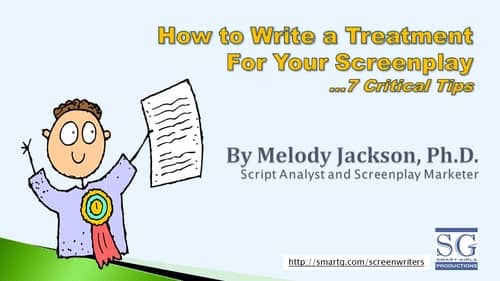Previously I wrote about the great benefits of writing treatments for your screenplays instead of jumping directly into writing the scenes themselves.
In case you missed it, that article is at What is a Film Treatment and 7 Awesome Reasons to Write One. One of the biggest advantages of writing treatments for your movie ideas, as I noted there, is that you can write a lot more of them. But before you can write any of them, you have to know How To Write a Treatment For Your Screenplay.
Here are 7 tips for writing a treatment for your screenplay, a movie script or an idea you have in your head. Actually there are more than 7 tips… but we’ll leave it at 7 since it’s on the title card. Think of it as getting the baker’s seven…. seven plus some bonus tips.
* Write your storyline as a very dense short story.
Since you’re only writing 3 to 5 pages, you can’t write everything that happens. Focus on developing the major elements of it, including the plot, characters, structure and theme.
Write it in a way that draws us in so we want to know what happens. Imagine you are telling the story by the campfire. Use colorful language and imagery to help us see it when we read the treatment.
Focus on the overall three-act structure of a beginning, middle, and end.
If you do it this way, you’re less likely to get bogged down in making it too long. However, if you use John Truby’s 22-step structure, or the hero’s journey steps, or Save the Cat, that’s fine, too. Just be sure it stays under 5 pages.
* Start by writing a two or three paragraphs to help you minify your story in your mind.
This will help you focus on the action line of the whole story as a starting point for writing your treatment.
Think of developing your story by telling it as a logline, then expanding it to 2 paragraphs, then half a page and so on. Just keep expanding the most important parts.
By starting with the story being really short, you have to focus on the core or central action line of the story. Then you decide what’s next most important and you add that into the story.
Developing a treatment is much like building a house. You create the blueprint. You get the bones of the drawing done. Then you build the structure for the rooms. Then you put the walls in. The last thing you do is paint it and do the detailed work. That’s how you write a treatment. It will not have all the detailed work. It will have the major movements and structure of the story.
A rule of thumb in terms of how much time to spend on any given section is to spend 25% of the page count or words on the First Act, 50% on the Second Act, and 25% on the Third Act. Correspondingly, focus on Setup in the first act, Conflict in the Second Act, and Resolution in the Third Act.
* Have major turning points between the first and second act and then between the second and third act.
Most screenplays I review do not have strong enough turning points. Your turning points between the acts need to change the direction of the story. It’s too much to go into that in detail here, but I mention this to remind you to create and include strong turning points in your treatment.
* Make sure the theme, the overall meaning and point of the story, comes through in your treatment.
Stories should always reveal something challenging about the human experience and then show how one character faces that challenge and typically wins — if we have a happy ending. If they don’t overcome it, it might be a sad ending, but hopefully we still see learn something about how we have to deal with sadness in life.
It’s very important to make sure your theme comes through in the treatment as it is the glue that holds the entire story together.
Now to a few formatting and logistical items.
Formatting the Treatment for Your Screenplay
* Introduce all major and supporting characters and write their names in ALL CAPS the first time we see them.
Just like in a screenplay, introduce your characters in caps, then use upper-lower case names after that. By putting the names in ALL CAPS the first time a character appears, it’s easy for the reader to go back to reference the basic description of a character so they can have a clear vision in their minds of who they are if they missed them the first time.
* Create a title that sets the mood and tone of your story.
I personally find movie titles to be challenging because they have so few words. Your title should indicate the genre of the movie, if possible.
Secondly, it’s always great when it has a double meaning. The film Braveheart refers to the name of the character and was also about a man who was very courageous… who had a brave heart.
Trip to Bountiful, one of my all-time favorite movies, refers to the town of Bountiful and also how the elder lady longed for the trip back to the place where she grew up because she imagined it would be so bountiful with great memories. Good titles typcially have more than one meaning or reference.
* Put the page number in the upper right corner of each page except for the first, and put the script title, your name and your contact info at the top center of the first page.
The first thing an exec or reader does is look at the last page to tell them how many pages they have to read. If there are no page numbers, it’s annoying and already a negative starting point.
I personally prefer to have my contact on every page I send out because as a marketer I want people to be able to reach me easily.
But with a screenplay or treatment, extraneous information can interrupt the flow of the read.
Another option is to put your contact info at the bottom of each page of the treatment — but never do that with a the screenplay itself. A final alternative is to put your last name or a shortened version of the title by the page number at the top of a treatment. But again… never put anything except the page number on a screenplay.
* Single space the treatment with a full blank line between paragraphs.
Your treatment for your screenplay should look much like how this article is written…. broken into small paragraphs of 3 or 4 lines each with an entire blank line between the paragraphs.
Your treatment will look more inviting when you have more white space on the page. It will look easier to read and will also actually be easier to read. Adding plenty of white space makes reading less harsh on the eyes.
* Use a 12-point font, either Courier, Arial, or Cambria fonts.
DO NOT CHEAT and reduce the size of your font to fit more onto 5 pages. You will be doing yourself a huge disservice if you reduce the size of the font. It will be harder to read and it will show that you were not able to focus on the heart of the story! Stick with a 12-point font.
As for what typeface, some screenwriters like to go old school and use a Courier font to keep the vibe of the script. When I see a treatment with a Courier font now, however, I feel like the writer is behind the times. (But always use a courier font on your screenplay. Anything other than that is dead wrong and looks unprofessional!)
For treatments, my personal preference is either the more contemporary Arial or Cambria font. Cambria is the serif font that replaced the Times Roman font as the most common default serif font.
~~~
With these tips in mind, you should be ready to work on a treatment.
By writing treatments, you’ll be more efficient in selecting your best ideas to write as a screenplay. You’ll also have more fun and stay motivated about your screenwriting since it’s much easier to work on multiple stories when you’re writing treatments. You’ll also be able to test out your ideas in a much shorter learning curve compared to writing the entire screenplay.
If you are serious about selling a screenplay or having a screenwriting career, you can’t afford to spend time writing a screenplay that has inherent issues.
Learn to write treatments well and you’ll actually get much faster at writing your screenplays. Ideally, you would write 3 or 5 treatments developing your ideas, then have them evaluated to help you pick the best one to write.
There are many reasons to take on learning how to write treatments, not to mention the fact that it helps you develop your basic story-telling craft.
If you like this idea and you want feedback on your treatment or screenplay, check out our script analysis services — one of them is a review of a treatment. We would love to help.


